How Leading Platforms Enhance Digital Customer Service

Digital customer service platforms are reshaping how you interact with businesses. These platforms streamline communication, allowing you to receive faster, more personalized support. AI-driven tools play a significant role in this transformation. For instance:
- 51% of customers now prefer bots for immediate assistance.
- Businesses using AI chatbots have cut routine tasks by 80%, enabling human agents to focus on complex issues.
- Companies like NIB saved $22 million by automating customer support, reducing phone calls by 15%.
This shift not only enhances your experience but also drives customer satisfaction and operational efficiency. Platforms like Sobot exemplify this innovation by unifying customer interactions across channels.
Understanding Digital Customer Service Platforms
What Is a Digital Customer Service Platform?
A digital customer service platform is a tool that helps businesses manage customer interactions across multiple channels. It collects and organizes customer data to create a unified view of each individual. This allows businesses to provide personalized and efficient support. These platforms act as a single source of truth for customer data, ensuring consistency in service delivery.
Here’s a breakdown of the types of data these platforms handle:
| Data Type | Description |
|---|---|
| Behavioral Data | Tracks actions like website visits, app usage, and interaction frequency. |
| Transactional Data | Includes purchase history, returns, and payment details. |
| Demographic Data | Covers basic information such as name, birth date, and address. |
By unifying this data, digital customer service platforms enhance personalization and improve the overall customer experience.
Why Businesses Need Digital Customer Service Solutions
In today’s competitive market, businesses rely on digital customer service solutions to meet rising customer expectations. Studies show that 73% of customers consider customer experience the most important factor when making a purchase. Additionally, 72% of customers expect immediate service, and 70% want businesses to have full context during interactions.
These solutions automate repetitive tasks, allowing agents to focus on complex issues. For example, 40% of customer interactions are now automated using AI and machine learning. This not only improves efficiency but also boosts customer satisfaction. Companies that prioritize customer experience management often see higher loyalty and revenue growth.
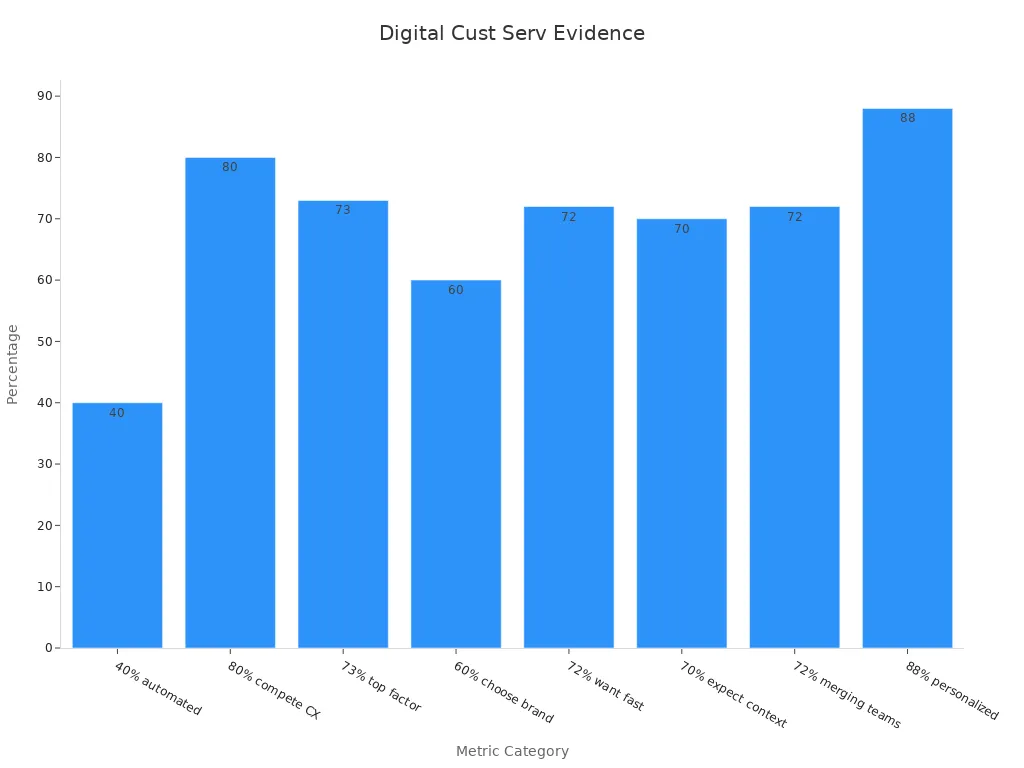
Common Applications Across Industries
Digital customer service solutions are versatile and cater to various industries. In retail, they help manage inquiries across social media, email, and chat. Financial services use these platforms to guide customers through complex processes. In gaming, they resolve player issues quickly with AI-driven insights. Education sectors benefit by providing students with instant self-service options for common queries.
These solutions also support self-service features like chatbots, which empower customers to find answers independently. This reduces the workload on agents and ensures faster resolutions. Across industries, digital customer experience solutions improve efficiency, enhance customer satisfaction, and drive business growth.
Key Features of Digital Customer Service Platforms

Omnichannel Support for Seamless Interactions
Omnichannel support ensures that your customers can interact with your business across multiple channels without losing context. Whether they reach out via social media, email, live chat, or phone, omnichannel customer support creates a unified experience. This feature allows you to meet customers where they are, providing consistent service across platforms.
For example, Sobot’s omnichannel solution integrates communication channels like WhatsApp, Facebook, and Instagram into a single workspace. This eliminates the need for agents to switch between systems, improving efficiency and reducing response times.
Key performance indicators validate the effectiveness of omnichannel support:
| KPI | Description |
|---|---|
| Brand Awareness | Measures visibility through metrics like Cost Per Impression (CPM) and social media engagement. |
| Conversions | Includes metrics like conversion rate and Cost Per Acquisition (CPA) to assess sales effectiveness. |
| Customer Retention Rate | Evaluates customer loyalty through Customer Lifetime Value (CLV) and churn rate. |
| Brand Advocacy | Assessed via Net Promoter Score (NPS) and online reviews to gauge customer loyalty and satisfaction. |
To maximize the benefits of omnichannel support:
- Clearly define your goals to improve specific metrics.
- Invest in ongoing agent training for better service delivery.
- Regularly monitor and analyze KPIs to identify areas for improvement.
- Encourage customer feedback to enhance service quality.
By implementing these strategies, you can create a seamless customer experience that fosters loyalty and satisfaction.
AI-Powered Tools for Automation and Efficiency
AI-powered tools revolutionize customer service by automating repetitive tasks and enhancing efficiency. These tools handle routine inquiries, freeing agents to focus on complex customer interactions. For instance, chatbots powered by AI can provide instant responses, reducing wait times and improving customer satisfaction.
Sobot’s AI-driven automation includes features like intelligent assignment and workflow automation. These tools ensure that inquiries are routed to the right agent, minimizing delays. Additionally, AI analyzes customer interactions to identify trends and optimize service delivery.
Performance metrics highlight the benefits of automation:
| Metric | Description |
|---|---|
| Customer Satisfaction | AI analyzes call tone and content to gauge satisfaction levels, identifying areas for improvement. |
| Trend Identification | Call analytics reveal common issues, helping businesses refine strategies. |
| Efficient Monitoring | AI reduces manual call monitoring, enabling faster and more accurate performance reviews. |
| Compliance Monitoring | AI checks calls for adherence to policies, protecting against legal issues. |
| Performance Analytics | Tracks response times, resolution rates, and customer satisfaction scores for evaluation. |
Additional metrics include:
- Escalation rates: Frequency of AI needing to escalate to human agents.
- Fallback intents: Instances where the AI fails to understand customer input.
- Customer Effort Scores: Measures how easy it is for customers to engage with the system.
- Repeat contact: Tracks if customers need multiple interactions for a single issue.
By leveraging AI-powered tools, you can streamline operations, reduce costs, and deliver faster resolutions, ultimately enhancing the customer experience.
Advanced Analytics for Data-Driven Decisions
Advanced analytics empower you to make informed decisions by providing actionable insights into customer behavior and preferences. These tools analyze data in real time, enabling you to identify trends and optimize your customer service strategies.
For example, platforms like Sobot use built-in analytics to evaluate over 150 indicators, helping businesses improve service quality. Metrics such as Net Promoter Score (NPS) and Customer Satisfaction Score (CSAT) are essential for measuring customer experience.
Industry leaders demonstrate the power of analytics:
- Amazon uses data analytics for personalized recommendations, enhancing customer engagement.
- Netflix analyzes viewer data to optimize content recommendations, reducing churn.
Companies that integrate analytics into decision-making processes often outperform their competitors. For instance:
- Businesses using analytics in strategic decisions are 2.5 times more likely to be high performers.
- Microsoft transformed its business model by leveraging data on cloud usage patterns.
- Progressive Insurance integrates analytics into all decision-making processes, enhancing their service offerings.
By adopting advanced analytics, you can gain a competitive edge, improve customer satisfaction, and drive business growth.
Integration with CRM and Other Business Tools
Digital customer service platforms thrive when they work seamlessly with other business tools. Integration with CRM systems and other software ensures that your team has access to all the information they need in one place. This connectivity improves efficiency, reduces errors, and enhances the overall customer experience.
For example, when a platform integrates with a CRM, it allows you to view customer histories, preferences, and past interactions in real time. This insight helps your agents provide personalized support without asking repetitive questions. Imagine a customer reaching out about a recent purchase. With CRM integration, your agent can instantly access the order details and resolve the issue faster.
Key features of integration include:
- Unified Data Access: All customer interactions and records are consolidated into a single system.
- Workflow Automation: Tasks like ticket creation and follow-ups are automated, saving time.
- Enhanced Collaboration: Teams across sales, marketing, and support can share insights effortlessly.
- Real-Time Updates: Changes in one system reflect immediately across all connected tools.
Sobot’s platform excels in this area by offering seamless integration with popular CRMs like Salesforce and HubSpot. It also connects with e-commerce tools like Shopify, ensuring that your business operations remain smooth and interconnected. This level of integration with other tools not only boosts productivity but also drives customer satisfaction by delivering faster and more accurate resolutions.
Tip: When choosing a platform, ensure it supports integration with the tools your business already uses. This will save you time and resources during implementation.
Scalability and Customization for Business Growth
As your business grows, your customer service needs will evolve. A scalable and customizable platform ensures that you can adapt to these changes without disruptions. Scalability allows you to handle increased customer interactions, while customization ensures that the platform aligns with your unique business requirements.
Scalable platforms grow with your business. For instance, if your customer base doubles, the platform should accommodate the additional workload without compromising performance. Customization, on the other hand, lets you tailor features to match your industry or operational needs.
Here’s why scalability and customization matter:
- Future-Proofing: A scalable platform prepares you for growth, avoiding the need for frequent upgrades.
- Cost Efficiency: Customizable features let you pay only for what you need, optimizing your budget.
- Enhanced Customer Experience: Tailored solutions ensure that your customers receive the best possible support.
The following table highlights how different business segments benefit from scalable and customizable platforms:
| Segment | Market Share (2023) | Key Insights |
|---|---|---|
| Large Enterprises | 57.9% | Dominated due to complexity of products and need for high-quality support. |
| SMEs | N/A | Projected growth driven by awareness of customer success benefits. |
| Sales & Marketing Optimization | 25.2% | Driven by advancements in data analytics and AI technologies. |
| BFSI | 17.8% | Focus on customer retention and reducing churn through data analytics. |
| North America | 36.01% | Leading region due to SaaS adoption and need for customer satisfaction. |
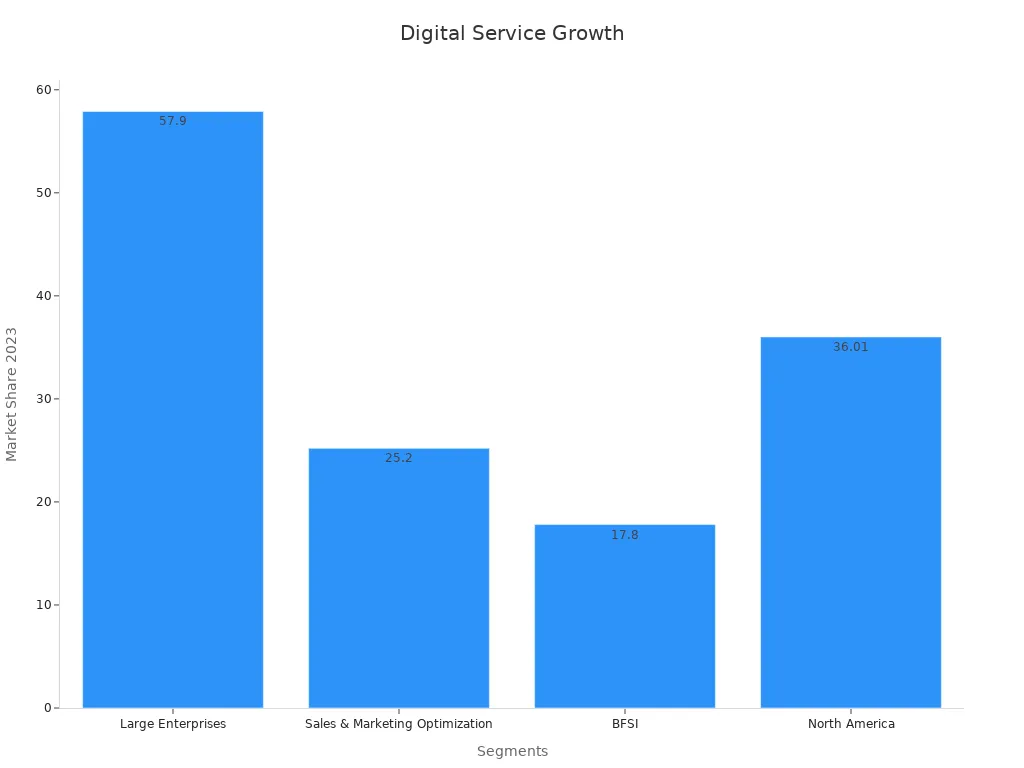
Sobot’s platform stands out by offering both scalability and customization. It supports businesses of all sizes, from startups to global enterprises. Features like omnichannel support and AI-driven automation can be tailored to meet your specific needs. Whether you’re in retail, financial services, or gaming, Sobot ensures that your platform grows with you.
Note: Always evaluate a platform’s scalability and customization options before committing. This ensures that it aligns with your long-term goals.
Comparing Leading Customer Support Platforms
Choosing the right customer support platform can transform how you manage customer interactions. Each platform offers unique features tailored to specific business needs. Below, we explore three leading customer service platforms—Zendesk, Freshdesk, and Salesforce Service Cloud—to help you make an informed decision.
Zendesk: A Comprehensive Customer Service Platform
Zendesk stands out as a robust solution for businesses seeking a comprehensive approach to customer support. Its tools focus on improving efficiency and customer satisfaction.
Key performance metrics highlight Zendesk's effectiveness:
- Ticket Resolution Rates: Zendesk helps your team resolve issues faster, boosting customer satisfaction.
- Response Times: Faster responses lead to happier customers, and Zendesk excels in this area.
- Customer Satisfaction Scores (CSAT): High CSAT scores reflect the platform's ability to meet customer expectations.
- First Contact Resolution (FCR): Zendesk ensures many issues are resolved in a single interaction, reducing follow-ups.
- Next Issue Avoidance: By addressing root causes, Zendesk prevents recurring problems, enhancing long-term satisfaction.
Zendesk's omnichannel capabilities allow you to manage customer interactions across email, chat, and social media. Its intuitive interface and powerful analytics make it a favorite among businesses aiming to streamline their support operations.
Tip: Zendesk is ideal for businesses prioritizing efficiency and customer satisfaction through data-driven insights.
Freshdesk: Simplified Digital Customer Service Solutions
Freshdesk offers a user-friendly platform designed for small to medium-sized businesses. Its simplicity and affordability make it a popular choice for companies looking to enhance their customer support without breaking the bank.
Freshdesk's key features include:
- Automation Tools: These reduce response times by handling repetitive tasks.
- Omnichannel Support: Freshdesk ensures consistent customer experiences across platforms like email, chat, and social media.
- Robust Analytics: These tools help you measure service impact and refine strategies.
- Unified Platform: Freshdesk consolidates multiple channels, streamlining communication and improving efficiency.
Performance metrics such as CSAT, NPS, and CES demonstrate Freshdesk's ability to deliver effective customer service. Regular monitoring of these metrics helps you identify areas for improvement and optimize your strategies.
Freshdesk's pricing starts at $15 per month, making it an affordable option for businesses with limited budgets. Its self-service portal and ticketing system further enhance the customer experience by empowering customers to find solutions independently.
Note: Freshdesk is best suited for small to medium-sized businesses seeking an affordable and straightforward customer service platform.
Salesforce Service Cloud: Enterprise-Grade Features
Salesforce Service Cloud offers enterprise-grade features designed for large organizations with complex customer service needs. Its advanced tools and integrations make it a powerful choice for businesses aiming to deliver exceptional customer experiences.
Key features of Salesforce Service Cloud include:
- Comprehensive CRM Integration: This ensures seamless access to customer data, enabling personalized support.
- Advanced Analytics: These tools provide actionable insights to optimize your service strategies.
- AI-Driven Support: AI enhances efficiency by automating routine tasks and improving customer interactions.
- True Omnichannel Connectivity: Agents can handle inquiries across various platforms without losing context.
Salesforce Service Cloud's pricing starts at $25 per month, offering excellent value for businesses requiring robust capabilities. It is particularly recommended for companies in niche industries that need extensive software customization.
Recommendation: Salesforce Service Cloud is ideal for large enterprises seeking a scalable, feature-rich platform to manage complex customer interactions.
Comparison Table
| Platform | Key Features | Pricing | Best Use Cases |
|---|---|---|---|
| Zendesk | Omnichannel support, powerful analytics, intuitive interface | Custom pricing | Businesses prioritizing efficiency and customer satisfaction |
| Freshdesk | Ticketing system, automation tools, self-service portal | Starts at $15/month | Small to medium-sized businesses looking for affordable help desk solutions |
| Salesforce Service Cloud | Comprehensive CRM integration, advanced analytics, AI-driven support | Starts at $25/month | Large enterprises requiring robust cloud-based customer service platforms |
This comparison highlights the strengths of each platform, helping you choose the one that aligns with your business goals.
Sobot: Enhancing Customer Engagement with Live Chat
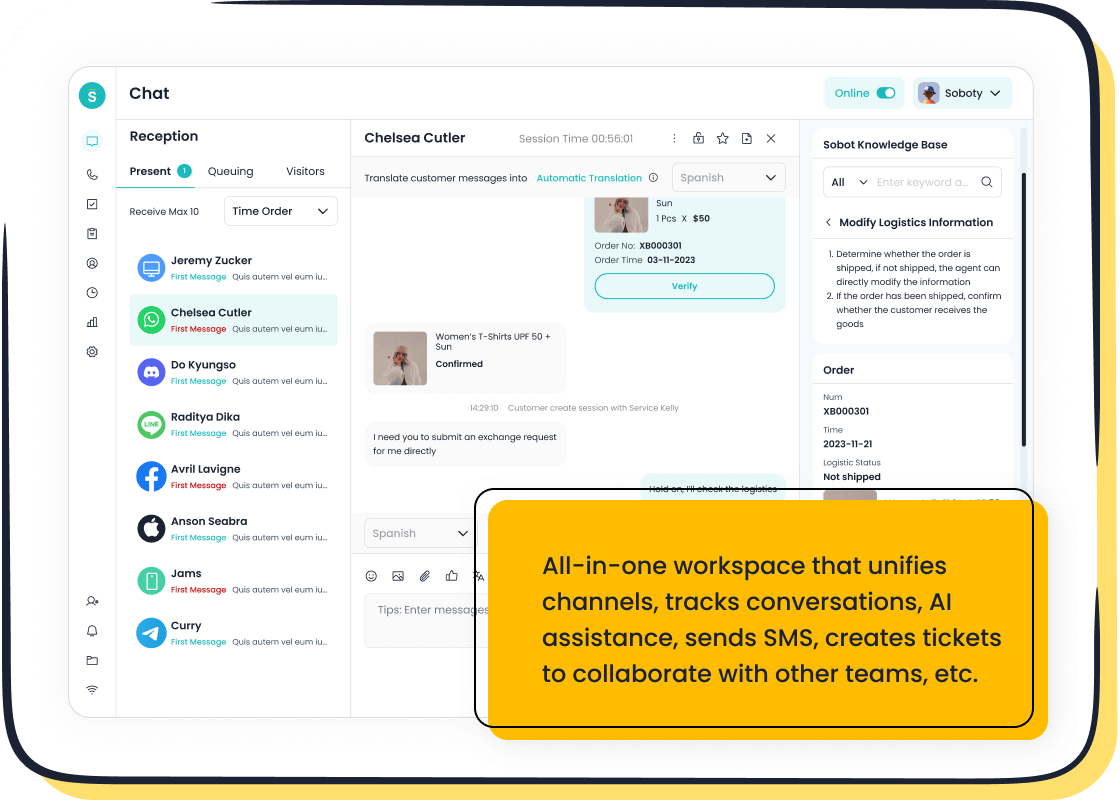
Sobot’s Live Chat platform empowers you to deliver exceptional customer support by enabling real-time, meaningful interactions. This tool consolidates customer interactions across multiple channels, ensuring a seamless experience for your customers. Whether they reach out via websites, apps, or social media platforms like WhatsApp and Facebook, Sobot ensures no conversation is missed.
The platform’s AI-powered tools enhance efficiency by automating repetitive tasks, allowing your agents to focus on complex issues. For instance, Sobot’s intelligent assignment feature routes inquiries to the most suitable agent, reducing response times. Additionally, its built-in analytics evaluate over 150 indicators, helping you make data-driven decisions to improve customer satisfaction.
Sobot Live Chat also excels in personalization. By leveraging customer data, it enables tailored interactions that foster loyalty and drive conversions. Businesses using Sobot have reported a 38% increase in conversion rates, showcasing the platform’s ability to turn visitors into loyal customers.
The following table highlights strategies employed by Sobot and their impact on customer engagement:
| Strategy | Impact on Customer Engagement |
|---|---|
| Meaningful Engagement | Boost retention by up to 30% |
| Personalized Experiences | Increase conversion rates by up to 20% |
| Omnichannel Strategies | Drives convenience and satisfaction |
| Community and Advocacy | Engaged customers are 67% more likely to recommend a brand |
| Loyalty Programs | Increase retention by 25% |
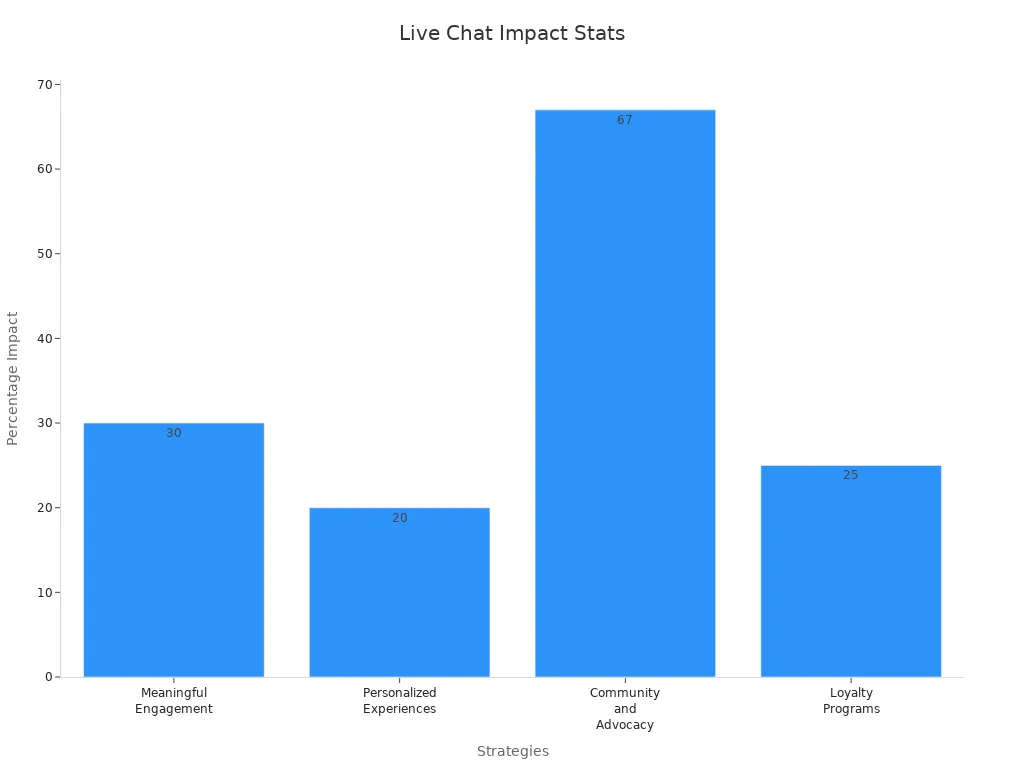
By integrating Sobot Live Chat into your operations, you can enhance customer satisfaction, improve retention, and drive business growth.
Key Differentiators and Use Cases
Sobot stands out in the crowded landscape of customer support platforms due to its unique features and proven results. Its omnichannel capabilities, AI-driven tools, and seamless integration with CRM systems make it a versatile solution for businesses across industries.
Key Differentiators:
- Omnichannel Support: Sobot unifies communication channels, ensuring consistent service across platforms.
- AI-Powered Efficiency: Automation tools handle routine tasks, freeing agents to focus on complex issues.
- Built-In Analytics: Over 150 indicators provide actionable insights to optimize your strategies.
- Customizable Features: Tailor the platform to meet your specific business needs.
- Scalability: Sobot grows with your business, accommodating increased customer interactions seamlessly.
Use Cases:
- Retail and E-commerce: Manage inquiries across social media and email, providing quick responses that enhance the shopping experience.
- Financial Services: Guide customers through complex processes with AI assistance, improving satisfaction.
- Gaming: Resolve player issues efficiently using AI-driven insights, ensuring a smooth gaming experience.
- Education: Offer students instant self-service options for common queries, reducing agent workload.
Samsung’s success story exemplifies Sobot’s impact. By implementing Sobot’s all-in-one contact center solution, Samsung achieved a 97% customer satisfaction rate and a 30% increase in agent efficiency. This demonstrates how Sobot’s tools can transform customer interactions and drive measurable results.
Tip: To maximize the benefits of Sobot Live Chat, invest in agent training and regularly analyze performance metrics. This ensures continuous improvement and a superior customer experience.
How to Choose the Right Digital Customer Service Platform
Identifying Business Needs and Goals
Start by defining what your business needs from a digital customer service platform. Consider your current challenges and long-term objectives. For example, are you looking to improve customer satisfaction, reduce operational costs, or streamline customer interactions? A 2023 Deloitte survey revealed that 98% of manufacturers have embraced digital transformation to enhance customer experience, optimize costs, and boost efficiency. This trend highlights the importance of aligning your platform choice with your goals.
Ask yourself these questions:
- What are your most common customer pain points?
- How many channels do your customers use to reach you?
- What level of automation do you need to handle repetitive tasks?
By answering these, you can identify the features that will best support your business.
Evaluating Features and Scalability
Once you’ve outlined your needs, evaluate the platform’s features and scalability. Look for tools that can grow with your business and handle increasing customer interactions without compromising performance. Key performance indicators (KPIs) can guide your evaluation:
| KPI Metric | Why It Matters for Scalability | Target Goal Example |
|---|---|---|
| Average Handle Time (AHT) | Reduces time spent on each interaction with AI support | < 5 minutes |
| First Response Time (FRT) | Instant responses improve customer satisfaction | < 1 minute (chat/bot) |
| Customer Satisfaction | Measures the quality of customer support | > 90% |
| Ticket Volume | Ensures the platform can handle growth | Accommodate 2x growth |
Case studies also demonstrate scalability in action. For instance, H&M’s AI resolved 70% of queries without human intervention, while Telstra improved agent effectiveness by 90%. These examples show how scalable platforms can transform your operations.
Budget and ROI Considerations
Budget plays a critical role in your decision. While upfront costs matter, focus on the long-term return on investment (ROI). Businesses that prioritize customer experience often see significant financial benefits. For example, customer experience initiatives can outperform the S&P 500 Index by 307%. Metrics like Customer Lifetime Value (CLV) and Churn Rate help you measure ROI effectively.
When evaluating costs, consider:
- Subscription fees and setup costs.
- Savings from automation and reduced agent workload.
- Revenue growth from improved customer satisfaction.
A well-chosen platform not only fits your budget but also delivers measurable value over time.
Importance of User Experience and Support
User experience plays a critical role in shaping how customers perceive your business. A seamless and intuitive experience ensures that customers feel valued and understood. When platforms prioritize user-friendly designs and personalized support, they create lasting impressions that drive customer satisfaction and loyalty.
Support quality is equally important. Customers expect quick and effective resolutions to their issues. A well-designed support system ensures that agents have the tools and information needed to address concerns efficiently. For example, platforms like Sobot provide agents with unified workspaces and AI-powered tools. These features enable agents to deliver personalized support, reducing response times and improving customer interactions.
The impact of user experience and support is evident in measurable outcomes. Businesses that focus on these areas often see significant improvements in key metrics:
| Metric | Outcome |
|---|---|
| Brand Recognition | 1.6 times increase |
| Average Order Value | 1.9 times higher |
| Companies exceeding business goals | 3 times more likely |
| Conversion Rate Improvement | 20% increase |
| Cart Abandonment Reduction | 15% reduction |
These results highlight the value of investing in user experience and support. By enhancing these aspects, you can improve customer satisfaction, boost conversion rates, and reduce cart abandonment. A focus on personalized support ensures that customers feel heard and appreciated, fostering long-term loyalty.
To achieve these benefits, choose platforms that prioritize user-centric designs and robust support systems. This approach not only enhances customer interactions but also drives business growth.
The Future of Digital Customer Service Platforms

Emerging Trends in Customer Support Technology
The future of customer support technology is evolving rapidly, driven by advancements in AI and changing customer expectations. Nearly 50% of CEOs believe that rising customer demands will push businesses to adopt technologies like generative AI. Gartner predicts that by 2024, 80% of customer service organizations will use generative AI to enhance customer interactions. This shift reflects the growing need for faster, more personalized support.
Emerging trends include AI-driven personalization, which anticipates customer needs before issues arise. Conversational AI bots are also becoming more human-like, offering engaging and natural interactions. These bots not only improve efficiency but also elevate the overall customer experience. Additionally, generative AI is being used to train customer service representatives, ensuring they deliver consistent and high-quality support.
The Role of AI and Machine Learning
AI and machine learning are transforming how businesses handle customer interactions. Nearly 50% of client support units have already implemented AI, with more investments planned for 2024. These technologies automate repetitive tasks, analyze customer feedback, and provide actionable insights. For example, Vodafone uses AI chatbots to manage inquiries, allowing agents to focus on complex issues. Similarly, Sephora’s virtual assistant helps customers discover products and book services, enhancing their shopping experience.
The adoption of conversational AI is also on the rise. Currently, 52% of contact centers have invested in this technology, and 44% plan to adopt it soon. Popular applications include routing requests, analyzing feedback, and enabling self-service tools. These innovations not only streamline workflows but also boost customer satisfaction by providing quick and accurate resolutions.
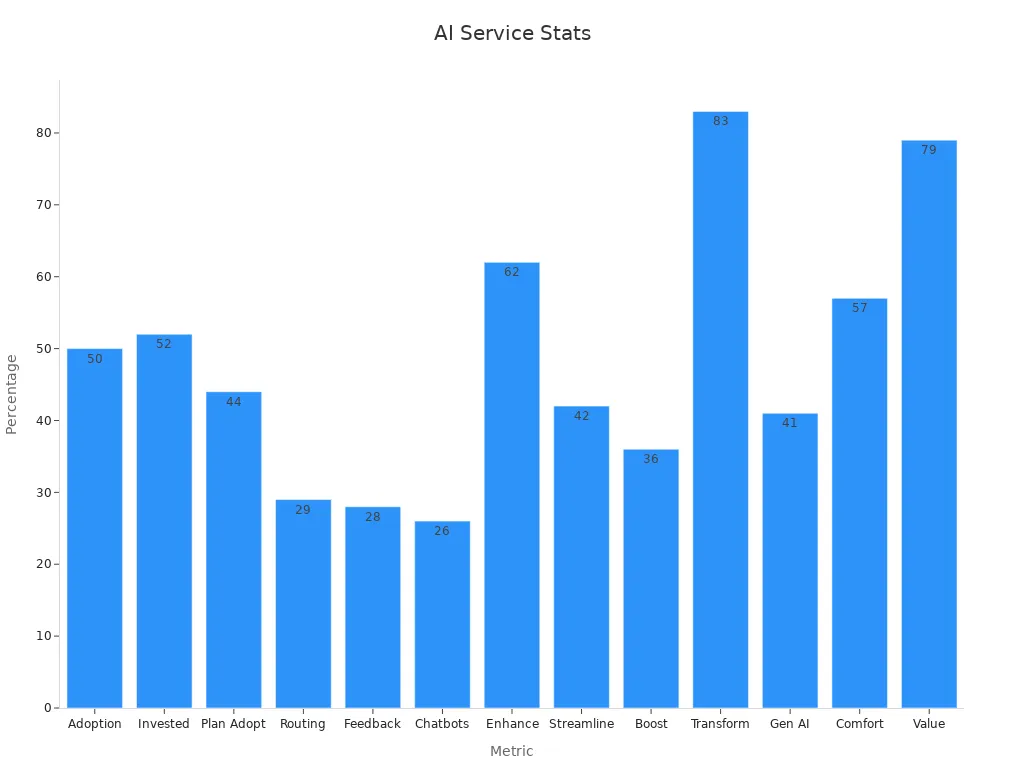
Predictions for the Next Decade
Over the next decade, digital customer service platforms will become even more intelligent and intuitive. AI-driven tools will dominate, enabling businesses to predict customer needs with remarkable accuracy. Conversational AI will replace traditional chatbots, offering seamless and human-like interactions. By 2030, most customer support platforms will integrate advanced analytics to provide real-time insights, helping businesses make data-driven decisions.
Generative AI will play a pivotal role in shaping the future. It will not only assist agents but also create personalized customer experiences. For example, AI could proactively suggest solutions before customers even report an issue. This level of anticipation will redefine customer satisfaction and loyalty.
As these technologies evolve, businesses must adapt to stay competitive. Investing in scalable and customizable platforms will ensure you meet the growing demands of your customers while maintaining operational efficiency.
Digital customer service platforms have revolutionized how businesses manage customer interactions. Organizations adopting these tools report a 25% improvement in customer service, showcasing their ability to enhance both efficiency and customer satisfaction. For example, automation through platforms like Intercom saved €50,000 ($55,000) in salary costs over five months, while AI-driven solutions improved resolution rates and engagement.
Choosing the right platform is essential for long-term success. A well-suited platform not only streamlines operations but also fosters meaningful engagement with customers. Sobot’s solutions, such as its Live Chat and omnichannel tools, empower businesses to deliver seamless support, improve customer satisfaction, and drive engagement. By integrating advanced analytics and AI-powered features, Sobot ensures your business stays ahead in delivering exceptional customer experiences.
Tip: Investing in a platform like Sobot can transform your customer engagement strategy, helping you build loyalty and achieve sustainable growth.
FAQ
What is the main purpose of a digital customer service platform?
A digital customer service platform helps you manage customer interactions across multiple channels. It organizes data, automates tasks, and ensures personalized support. This improves efficiency and enhances customer satisfaction.
How does Sobot Live Chat improve customer engagement?
Sobot Live Chat consolidates all customer interactions into one workspace. It uses AI tools to automate tasks and personalize responses. This approach boosts efficiency and increases conversion rates by 38%.
Can digital customer service platforms integrate with other tools?
Yes, most platforms, including Sobot, integrate seamlessly with CRMs, e-commerce tools, and other business systems. This ensures smooth operations and provides agents with real-time access to customer data.
Why is omnichannel support important for businesses?
Omnichannel support allows you to interact with customers on their preferred platforms. It ensures consistent service across channels like social media, email, and live chat. This improves customer satisfaction and loyalty.
How do AI-powered tools enhance customer service?
AI tools automate repetitive tasks, analyze customer interactions, and provide actionable insights. They reduce response times and help agents focus on complex issues, improving overall service quality.
Tip: Explore platforms like Sobot to experience the benefits of AI, omnichannel support, and seamless integration firsthand.
See Also
Essential Advice for Selecting Social Media Support Tools
Comprehensive Overview of Omnichannel Call Center Solutions
Best Customer Support Software Picks for 2024
